August 2017 / University of the Punjab / Biomedicine & Pharmacotherapy
Texte/ Wu Tingyao
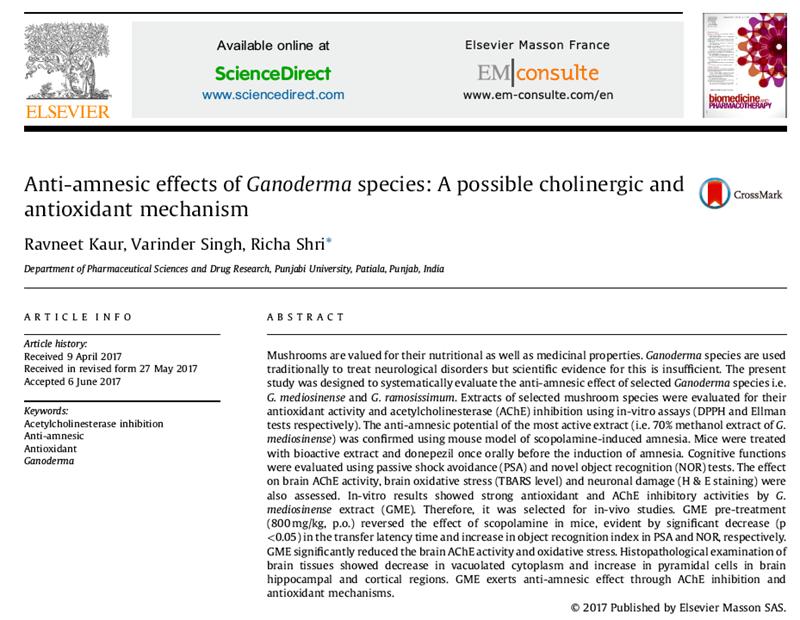
Before introducing scientists’ new findings on how reishi prevents amnesia, let’s take a look at a few concepts and terms.
The reason why the brain can recognize and remember the meaning of a person, event, or thing is that it relies on chemicals such as acetylcholine to transmit messages between nerve cells that control cognition and memory. When acetylcholine completes its task, it will be hydrolyzed by “acetylcholinesterase (AChE)” and then recycled by nerve cells.
Donc, the presence of acetylcholinesterase is normal. It can offer a breathing space to nerve cells so that nerve cells will not always be in a tense state of receiving and sending messages.
The problem is that when acetylcholinesterase is abnormally activated or its concentration is too high, it will cause a sharp decrease in acetylcholine, affecting the connections between nerve cells and causing cognitive and memory degeneration.
A cette époque, if the oxidative pressure in the brain is too high, causing a large number of deaths of nerve cells in charge of cognition and memory, the situation will be even worse.
Too much or overactive acetylcholinesterase and excessive oxidative stress have been considered to be the key factors that cause Alzheimer’s and amnesia. Clinical therapeutic drugs such as donepezil (Aricept film-coated tablets) are commonly used to delay the deterioration of amnesia by inhibiting acetylcholinesterase.
Ganoderma also has the effect of treating amnesia
A study published in the latest issue of “Biomedicine & Pharmacotherapy” by the Department of Pharmaceutical Science and Pharmaceutical Research, the University of the Punjab, Inde, pointed out that Ganoderma alcohol extract can reduce the activity of acetylcholinesterase, reduce the oxidative stress of the brain, and prevent the deterioration of cognitive and memory abilities.
The author of the paper stated that past studies have confirmed that certain Ganoderma strains (tel queGanoderma lucidum etG. boninense) can protect the nervous system through anti-oxidation and inhibition of acetylcholinesterase. Donc, they choseG. mediosinense etG. ramosissimum, which have not been studied in this aspect but are also produced in India, for research in the hope of adding new impetus to the pre-treatment of amnesia.
Since in vitro cell experiments showed that for the same extraction with 70% methanol, G. mediosinense extrait (GME) was obviously better than another type of Ganoderma in antioxidation and acetylcholinesterase inhibition, so they used GME for animal experiments.
Mice that eat Ganoderma are less prone to amnesia.
(1) Know how to avoid electric shock
The researchers first gave mice GME or donepezil, which is commonly used to treat amnesia, and injected scopolamine (a drug that inhibits the effect of acetylcholine) 30 minutes later to induce anmesia. Thirty minutes after the injection and the next day, the mice were evaluated for their cognitive and memory abilities through the “Passive Shock Avoidance Experiment” and the “Novel Object Recognition Experiment”.
The passive shock avoidance experiment (PSA) is mainly to see whether mice can learn from experience “to stay in a bright place and keep out of a dark room to avoid being electrically shocked.” Since mice are naturally like hiding in the dark, they must rely on memory to “force themselves to hold back.” Therefore, the length of time they stay in the bright room can be used as an evaluation indicator of memory.
The results are shown in [Chiffre 1]. The mice that had been fed with Donepezil and GME in advance were able to maintain better memory when faced with scopolamine damage.
Fait intéressant, the effect of low and medium doses (200 et 400 mg/kg) of GME was not significant, but the effect of high doses (800 mg/kg) of GME was significant and comparable to that of Donepezil.
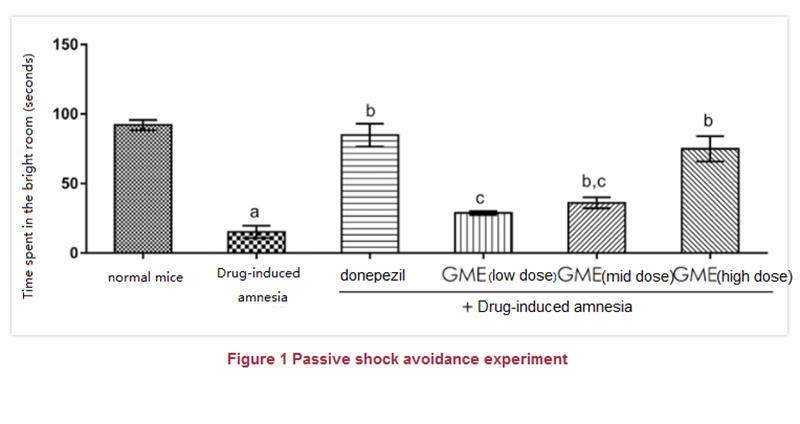
(2) Can recognize novel objects
The “novel object recognition experiment (NOR)” uses the instinct of a mouse to be curious and like to try fresh to test whether it can distinguish between the familiar one and the new one in two objects.
The ratio obtained by dividing the time the mouse takes to explore (sniff or touch with the body) a new object by the time it takes to explore the two objects is the “recognition index (RI)». The higher the value, the better the cognitive and memory abilities of the mouse.
The result was shown in [Chiffre 2], which was exactly the same as that of the previous passive shock avoidance experiment-mice that had previously eaten Donepezil and GME performed better, and the effect ofG. mediosinense was proportional to the dose.
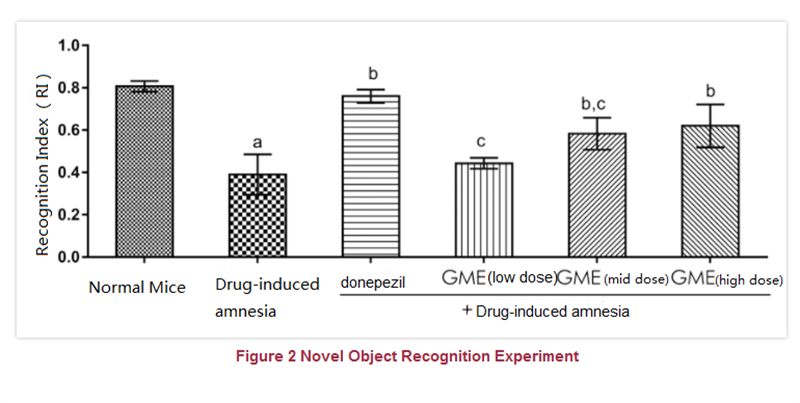
The anti-amnesic mechanism of Ganoderma
(1) Acetylcholinesterase inhibition + antioxidation
Further analysis of the brain tissues of mice showed that scopolamine greatly increased the activity of acetylcholinesterase and oxidative pressure. Cependant, high-dose GME not only reduced the activity of acetylcholinesterase in mice to normal levels (Chiffre 3) but also significantly reduced the oxidative damage suffered by mice (Chiffre 4).
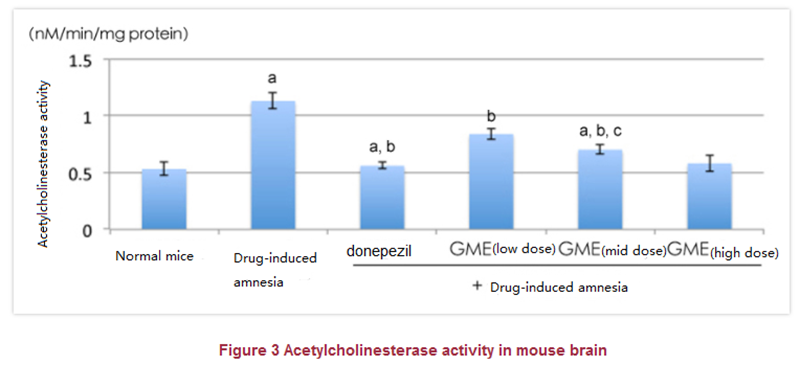
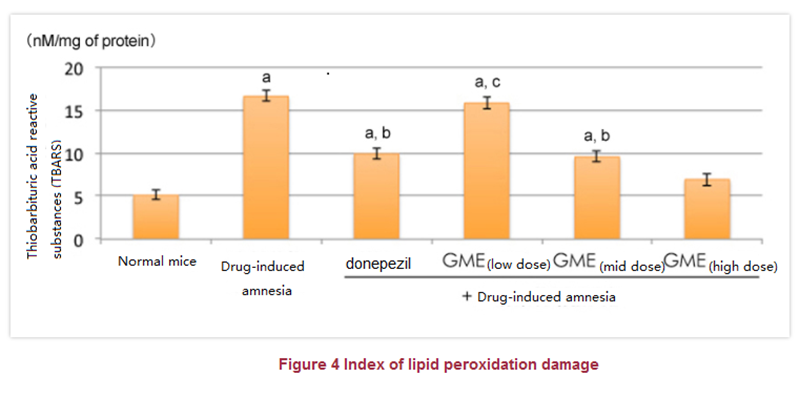
(1) Protect the integrity of brain nerve cells
En outre, the researchers also used tissue staining sections to observe the hippocampal gyrus and cerebral cortex of mice.
These two parts of the brain are the most important areas in charge of cognition and memory. The nerve cells in them are mostly in pyramidal forms, which can effectively transmit and receive information. The presence of cytoplasmic vacuolation in cells reflects the pathologic features of amnesia.
It can be observed through the tissue staining section that scopolamine will reduce the pyramidal cells and increase the vacuolated cells in these two brain regions. Cependant, if the areas are protected with GME in advance, the situation can be reversed: the pyramidal cells will increase while the vacuolating cells will decrease (see page 6 of the original paper for details).
“Phenols” are the active source of Ganoderma against amnesia.
In conclusion, in the face of risk factors of amnesia, a high concentration of GME can maintain normal cognitive and memory functions by inhibiting acetylcholinesterase, reducing oxidative stress, and protecting nerve cells in hippocampal gyrus and cerebral cortex.
Since every 1 gram of GME contains approximately 67.5 mg of phenols, which have been proven to inhibit acetylcholinesterase and be antioxidative in the past, researchers believe that these phenols should be the source of Ganoderma’s anti-amnestic activity.
Since drugs used clinically to treat amnesia can stimulate gastric peristalsis and have side effects such as nausea, vomissement, mauvais appétit, diarrhea or constipation, natural medicines such as Ganoderma extract that can prevent and treat memory loss are more worthy of our expectation.
Eat Ganoderma early to avoid Alzheimer’s Disease
Dementia is a global problem. And judging from the current trend, it will only get worse.
While human beings are celebrating the annual increase in average life expectancy, dementia has become the biggest worry for the elderly. If old age can only be spent in dementia, what is the meaning of longevity?
So eat Ganoderma early! And it is best to eat Ganoderma which contains the “alcohol” extract of the fruiting body. Après tout, only a sober old age can give happiness to oneself and to children.
[Source] Kaur R, et autres. Anti-amnesic effects of Ganoderma species: A possible cholinergic and antioxidant mechanism. Biomed Pharmacother. 2017 Août; 92: 1055-1061.
FIN
À propos de l'auteur/Mme. Wu Tingyao
Wu Tingyao rapporte des informations de première main sur le Ganoderma depuis 1999. Elle est l'auteur de Guérir avec Ganoderma (publié dans The People's Medical Publishing House en avril 2017).
★ Cet article est publié sous l'autorisation exclusive de l'auteur.
★ Les œuvres ci-dessus ne peuvent pas être reproduites, extrait ou utilisé d’une autre manière sans l’autorisation de l’auteur.
★ Pour les violations de la déclaration ci-dessus, l'auteur assumera les responsabilités juridiques pertinentes.
★ Le texte original de cet article a été rédigé en chinois par Wu Tingyao et traduit en anglais par Alfred Liu.. S'il y a une divergence entre la traduction (Anglais) et l'original (Chinois), le chinois original prévaudra. Si les lecteurs ont des questions, veuillez contacter l'auteur original, MS. Wu Tingyao.



